
A Canadian Forces helicopter takes off after leaving a load of soldiers at the point where the Rocky Mountain Rangers will start their tactical exercise, on Jan. 26, 2019. This is reportedly the first time in nine years this group has gotten to practice with helicopters.
(SHELBY THEVENOT / iNFOnews.ca)
January 28, 2019 - 6:30 PM
WILLIAMS LAKE - For civilians and soldiers alike, getting to ride in a helicopter is a golden opportunity.
About 30 soldiers from Kamloops, Prince George and the surrounding area met at a military training camp in the Rockies this weekend for a regular field-training mission, this time with a rare addition of helicopters.
The Rocky Mountain Rangers are a reserve unit, meaning when the Canadian Army needs more hands, these soldiers are available. Most work regular jobs and do this part time. They train in Kamloops and Prince George, and are comprised of men and women from the surrounding area. Capt. Michael Oviatt has been with the rangers for thirteen years. He says only one time in his years with the Rangers have they been used— nine years ago
"In the time when we request [the helicopter] something comes up," Oviatt says. "They’ll need to support search and rescue, whatever the case is so we get a lot of cancellations."
Helicopters are never guaranteed, as the Canadian Air Force's purposes takes priority. Soldiers arrived at Camp Chilcotin, the training grounds, at midnight on Friday, Jan. 25 and even then no one was certain whether or not the helicopters would be a go.
Saturday morning, the day of the training, crews had to melt ice off the helicopter's blades from freezing rain. It turned out to be a cloudy day, but a good day to fly.
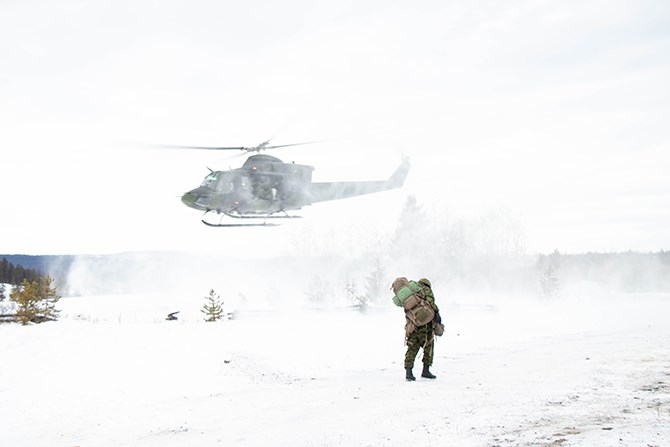
The helicopter creates formidable winds as it lifts off from the ground. It is not snowing but the force from the blades kicks up snow and blows it for several meters as a soldier walks towards the landing zone.
(SHELBY THEVENOT / iNFOnews.ca)
It was also a special day for a father and son duo — pilot Brian Griffith and his son Ty Griffith were working together for the first time.
Though Ty got to go in the helicopter as a kid, this was the first time they are working jointly on an exercise. When the exercise is over on Sunday, they plan to fly back to Edmonton together.
"[I'm] very, very proud, yeah," Brian says about his son.
When asked how he feels about flying with his dad, Ty jokes, "I think I'm in the other helicopter actually but that's OK, it's safer over there."
The 23-year-old is one of the part time soldiers that make up the Rocky Mountain Rangers. Ty goes to university in Prince George.
"I did want to be a pilot at first... but the infantry is just as fun," Ty says, who is not able to be a pilot due to colour blindness.
"You can't hold ground without infantry, We're the back bone of the army," Oviatt adds.
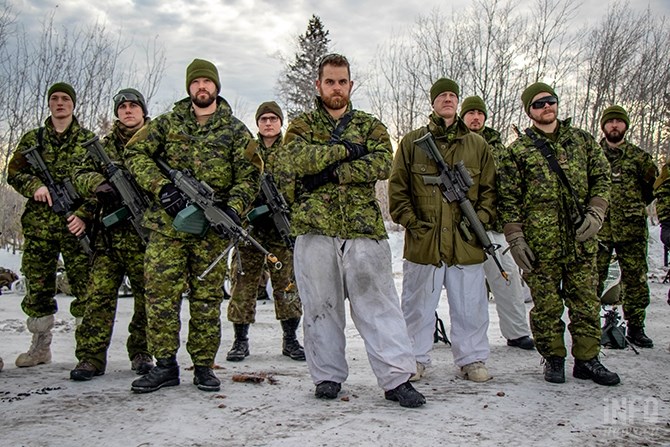
The Rocky Mountain Rangers are chiefly part time soldiers who are trained to help the Canadian army during local, national and international deployments.
(SHELBY THEVENOT / iNFOnews.ca)

Brian Griffith has been flying for about 30 years. For the tactical training exercise he is the pilot of the lead helicopter that will take the soldiers to the drop off point in the middle of the woods.
(SHELBY THEVENOT / iNFOnews.ca)
Though they are part time soldiers, they can still sign up to do national and international deployments. That means, while they do partake in humanitarian efforts like flood relief, combat is another important part of their training.
This weekend's tactical exercise was meant to allow them to practice loading and unloading the helicopters, using the equipment to keep themselves safe and to survive the elements.
Had the helicopters not come they still would have practiced combative operations.
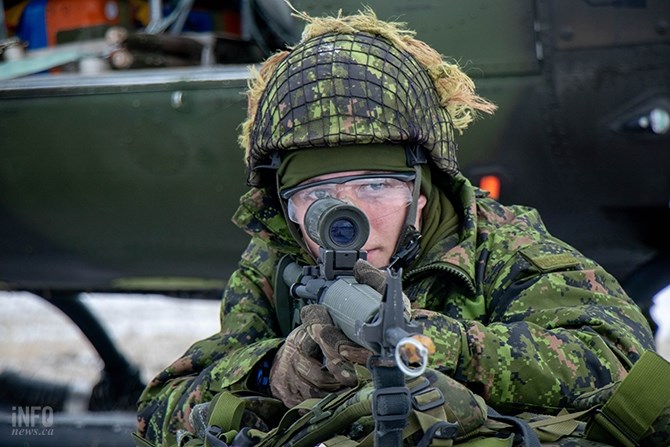
After getting out of the helicopter soldiers had to mount their weapons facing away from the aircraft. Here a man holds his gun fixed with a yellow stopper, meaning it is being used for practice. The weapons were loaded with blanks for the exercise.
(SHELBY THEVENOT / iNFOnews.ca)
They got to do two runs on the helicopter that day. The first time they were practicing with the safety equipment, and were brought on a tour around Camp Chilcotin.
The area had been touched by the fires of 2017, and there were large patches of charred stocks that were once trees. The lakes were covered in snow and could have easily been mistaken for bare patches.
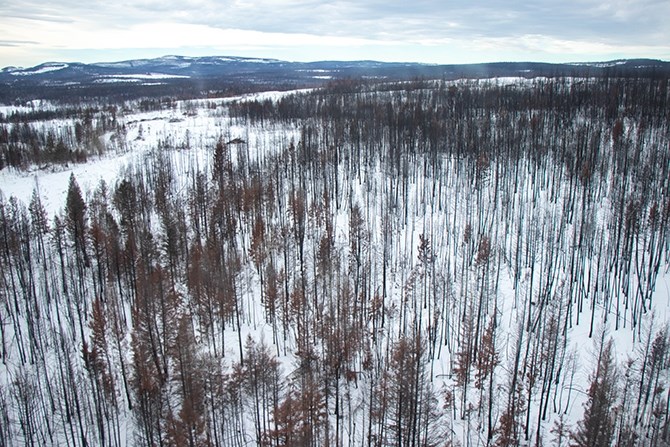
Bare trees that had been burned in the 2017 wildfires could be seen through the helicopter's window.
(SHELBY THEVENOT / iNFOnews.ca)
After a tour on the helicopters, the participants would get their orders and intelligence to start the exercise that afternoon.
"We built a little bit off a scenario, we’ve set things up so that we have an enemy camp," Oviatt explains. "They'll know approximately where the enemy location will be though we do hope to move it slightly just to catch them on guard. They have fake intelligence that indicates about how many people they can expect."
The point of the "fake intelligence" is to put them into a position where they have to re-evaluate, come up with a new plan and then execute.
But first, lunch.
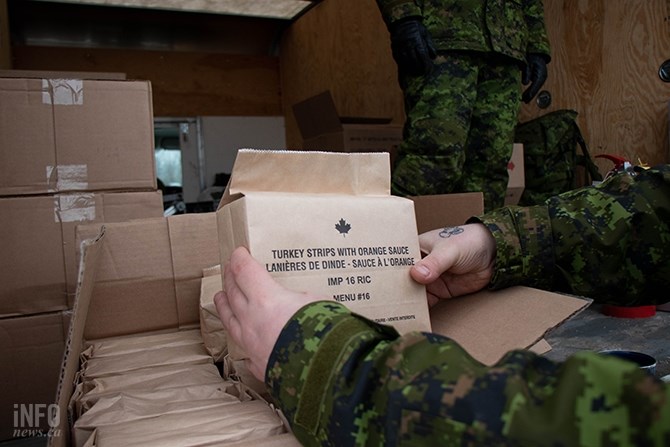
Military personnel get rations, which are non-perishable and contain something approaching 2000 calories. They include a meal, bread, desert, a snack bar of some sort, a couple of drink mixes and a mint.
(SHELBY THEVENOT / iNFOnews.ca)
Canadian Forces put some real effort into improving their rations since their involvement in the war in Afghanistan. The paper bags containing non-perishable food items at one time contained comment cards, which soldiers could fill out to suggest improvements.
Since then, the food has become more diverse. Indian chicken, turkey in orange sauce, and poutine are some of the things you can find on the menu. There are even vegetarian, halal, and kosher options.
Those with dietary restrictions get reimbursed for supplying their own groceries.
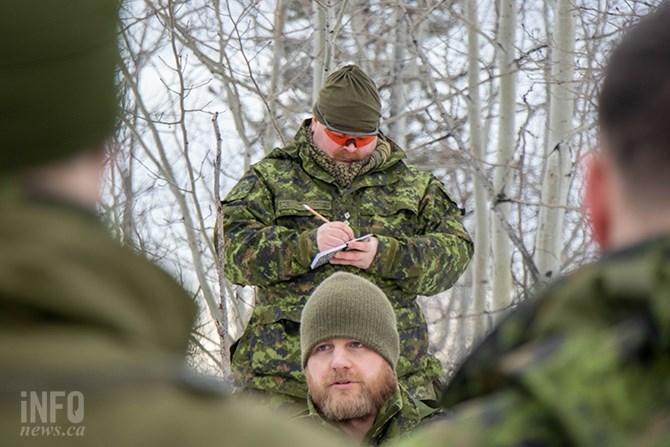
Capt. Michael Oviatt (top) writes notes as Lt. Max Birkner gives orders.
(SHELBY THEVENOT / iNFOnews.ca)

Lt. Max Birkner (centre) uses a map made from sticks and cardboard to illustrate their plan of attack.
(SHELBY THEVENOT / iNFOnews.ca)
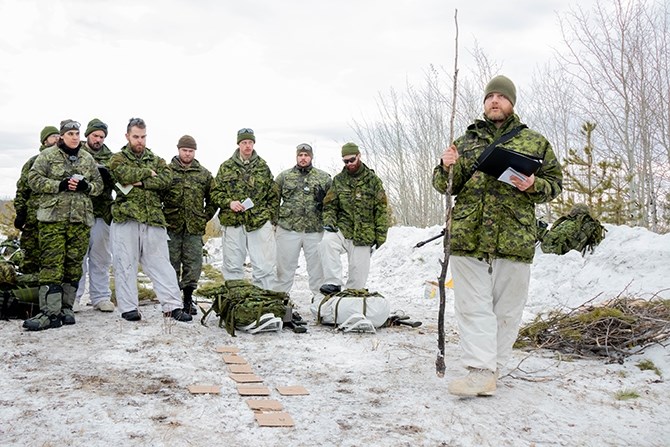
Beside the map there is a cardboard depiction of how the teams should distribute their members.
(SHELBY THEVENOT / iNFOnews.ca)
Lt. Max Birkner is in charge of the practice mission. After everyone has had their rations he designates roles for teams, and relays the intel.
"This scenario is one we’ve been going with all year," he explains. "It was thought up by one of our members in Prince George."
They are calling the land “Chilcotia” and an enemy is challenging the sovereignty of the area. The enemies are played by some of the more senior members like Sgt. Sean Chard who used to be full time infantry and now does human resource work.

Some of the participants include Pte. Jordan Brears (centre), 23, a carpenter from Quesnel, B.C. and Pte. James Armstrong Cormier (left), 22, a Kinesiology student from Prince George. "We know we’re not gonna sleep," Armstrong Cormier says. "We’re going to be cold, but... you look back and it’s such a fun memory."
(SHELBY THEVENOT / iNFOnews.ca)

Capt. Kieran Van Wagoner shows off his utility belt that holds everything he will need to survive in the forest in case he has to ditch his rucksack. Glow sticks, radio, GPS, food, water, and a knife are just some of the things he keeps on him.
(SHELBY THEVENOT / iNFOnews.ca)
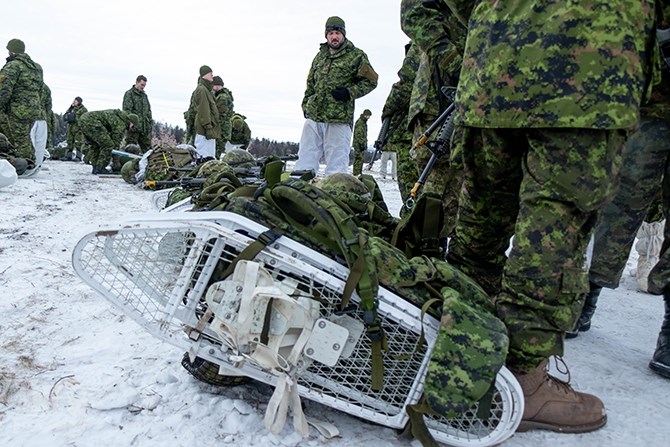
Rucksacks containing, bedding, rations, weapons, clothing and anything else the soldiers will need are lined up in the snow. The sacks can weigh anywhere from approximately 65 pounds (29.5 kilograms) to 95 pounds (43 kilograms) depending on what equipment they take with them.
(SHELBY THEVENOT / iNFOnews.ca)
Though the Rocky Mountain Rangers have their work cut out for them, and a few curve balls coming their way, it's no mission impossible.
"We’ve arranged things so that they will meet success," Oviatt says. "Because in the course of a weekend exercise we want to end on a positive note."
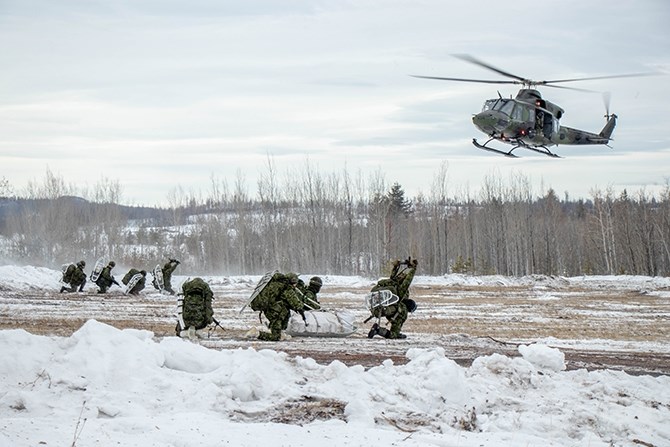
The soldiers wait in formation for the helicopters to land. They know exactly which seat they will take and where to put their equipment.
(SHELBY THEVENOT / iNFOnews.ca)
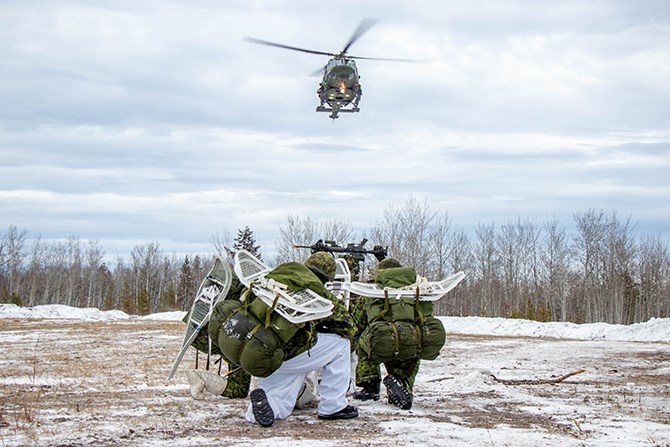
Four soldiers line up as practiced waiting for the helicopter to take them from their base camp to the drop off point where they will start the combat training.
(SHELBY THEVENOT / iNFOnews.ca)
READ MORE: iN PHOTOS: Seven moments from the Change of Command Parade in Kamloops
To contact a reporter for this story, email Shelby Thevenot or call (250) 819-6089 or email the editor You can also submit photos, videos or news tips to the newsroom and be entered to win a monthly prize draw.
We welcome your comments and opinions on our stories but play nice. We won’t censor or delete comments unless they contain off-topic statements or links, unnecessary vulgarity, false facts, spam or obviously fake profiles. If you have any concerns about what you see in comments, email the editor in the link above.
News from © iNFOnews, 2019